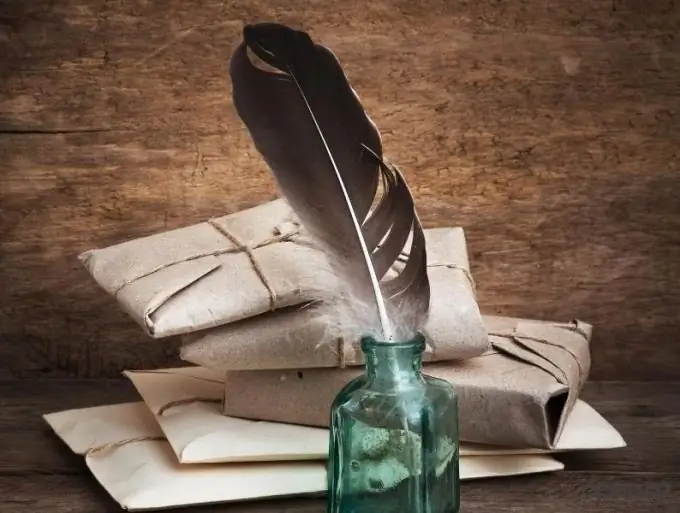- Author Antonio Harrison [email protected].
- Public 2023-12-16 07:44.
- Last modified 2025-01-22 21:44.
History suggests that the development of writing would have been impossible without the use of bird feathers. Moreover, the feather of not every bird was suitable for writing, but only certain species of waterfowl and non-waterfowl.

Waterfowl
Among waterfowl, swan and goose feathers were most valued, although duck feathers were also used. The feathers of the left wing of a goose were considered suitable for right-handers. Flight feathers were used, and from one goose only about ten elements were suitable. Why was the quill pen considered the most valuable for writing? Unlike other birds, a goose feather is a thick, hollow shaft that has a porous base. This allowed the hand to hold it firmly. Thanks to the inclined cut of the nib with a knife, the porous interior was exposed, which absorbed ink well. This made it possible to dip it into the inkwell less often. Also, the tip of the feather was moderately soft, due to which it retained its shape longer, which saved the owner from frequent sharpening.
For all these properties to be useful, it was necessary to properly prepare the pen for writing. For this, one outer feather or five feathers of the left wing was pulled out from a young and healthy goose. After that, it was necessary to cut off part of the beard so that it was convenient to grasp the rod. However, it was too early to use writing instruments. An important stage is the digestion of the feather in alkali for about fifteen minutes. This made it possible to degrease it well. The process did not end there - it was necessary to harden the feather dried after the previous stage. For this, hot sand was used, the temperature of which did not exceed 65 degrees. The pen could be used after sharpening the tip - for this they took an ordinary penknife.
Goose feathers had certain drawbacks. For example, the writing speed with their use was slow. They also made a loud noise and creak. The slightest inaccuracy resulted in ink splatter. It was impossible to press hard on the pen, otherwise its tip quickly unrolled and grinded. With regular writing, the pen lasted no more than a week, after which it was sharpened.
The quill pen is considered a symbol of poetry and literary creativity. It was used for a very long time, until the end of the eighteenth century. The famous A. S. Pushkin wrote great works and portraits with a quill pen. Studies have shown that there were over fifty portrait sketches created in this way. As you can see, the great poet appreciated the quill as a good writing tool.
Other birds
Not only waterfowl feathers were used. In principle, it was possible to write with any bird feather that had a suitable size and a normal tubular structure. Some calligraphers prized black grouse feathers. They could also use the feathers of a hawk, ostrich, peacock, raven.
By the way, in Russia, even in the nineteenth century, it was bird feathers that were used, but many writers did not trust anyone in the process of preparing feathers for writing. Good, high-quality feathers were even given to each other as a sign of respect and special affection.






